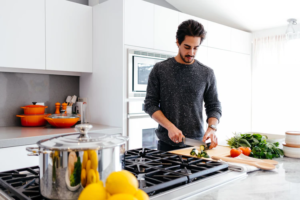With the meteoric rise of technological solutions for everyday lives, the various features of our many home appliances have made it harder to assess safety standards and requirements. Take some steps to ensure maximum safety for you and your loved ones in the kitchen. Here are five essential safety measures for your food appliances.
#1 Unplug Your Appliances When Not In Use
Any electrical appliance, when turned on, poses a risk for electrical shock. By unplugging your kitchen appliances, you reduce that risk to zero. You are also drastically reducing the risk of power surges. Most electrical appliances still apply up energy when turned off but plugged in. This phenomenon is known as phantom energy, so unplugging can also save you some money on your electricity bill.
That said, don’t let any cords hang loose. Children may trip and burn themselves from hot cooking appliances like crock pots or slow cookers. Never wrap flexible cords around equipment while it is still warm from use.
It’s best to invest in those models that include breakaway connectors. Such connectors ensure that cords don’t snag. This feature reduces the chance that the appliance will fall when its wire is pulled.
Always keep plug-in appliances away from the sink. There is always a chance that it could fall into a metal sink full of water and create an electric shock risk.
#2 Keep An Eye On What Is Cooking

The NFPA’s latest report (National Fire Protection Association) declared unattended cooking the leading cause of cooking fires and the number of casualties. 31% of home cooking fires came from unattended equipment. Fires from cooking activities cause upwards of $1 billion in direct property damage.
Always read the instructions manual for your appliances. They will include proper cooking times and how to reduce potential hazards.
Set the correct cooking time on your microwave and keep an eye on the food. Most models have sensors that detect fires and automatically switch off in the event of a fire. If your microwave catches fire, unplug it and do not open its door until the fire dies away. It would be better if you could Install an atex enclosure with window for a flameproof compartment because it could prevent high temperature and explosion effectively.
Get a small chemical or CO2 fire extinguisher for your kitchen, and make sure you know how to use it. You can’t be reaching for the instructions manual with flames brewing inside your kitchen. Grease fires need to be extinguished by placing a lid over the container, pouring salt or baking soda over the fire.
If you catch fire, leave whatever you are handling, then:
- Stop moving
- Drop to the ground
- Roll
#3 Do Not Cook With Loose Clothes

Clothing ignitions have led to 8% of the home cooking fire deaths in the past couple of years. Loose clothing can catch fire before you even realize it.
Also, tie your long hair back while cooking. Loose hair, too, can accidentally catch fire while you’re bending over. Not to mention you can end up with hair in your food!
Those advertisements are poor examples of basic kitchen safety rules–– never cook while wearing dangling jewelry. Your bracelet can get tangled around pot handles and cause you to spill hot food.
Always keep a pair of potholders nearby and use them when picking up hot dishes. Never leave them beside heat or an open flame.
#4 Regularly Inspect Your Food Appliances
Routinely check your appliances for frayed cords, unusual sounds, and other defects. Do not overlook exposed wiring; they possess the most risk and require immediate repair or replacement. Check for any loose parts before using the equipment. Do not overfill pans, pots, or kettles–– hot food may spill and cause burns.
If you spot some concerning quirk while the device is in use, immediately stop using it and get a professional to check it out. Contact the manufacturers to obtain any spare parts from them if you ever need a replacement.
Avoid extension cords in your kitchen as far as possible. It is possible for an extension cord to overload the circuit and cause a fire inside the kitchen.
Plug cooking appliances directly into an outlet and turn them on only after you have plugged them in. Never leave your cooking equipment unattended while it is in use. Always try to get the glass bottles used in your kitchen from reliable sources.
#5 Make Sure Your Appliances Have Required Certifications
Canadian, European, and American regulators all have slightly different product safety requirements. If you are importing your food appliances, make sure they meet the required safety certifications.
Read the directions manual and check if your kitchen is equipped for safe use of the appliance. For example, some devices need a higher or lower voltage outlet. Plugging in without a transformer will likely do irreversible damage to the cooking equipment or even cause a fire.
In the United States, kitchen appliances must follow the guidelines provided in part 21 of the CFR (Code of Federal Regulations). It is illegal to sell imported food appliances in the country if they do not conform to the regulations.
Choose home products with NSF certifications–– these products are internationally recognized for home use. This certification ensures your cookware products are made with safe materials and will not leach contaminants into the food. This is important to consider when you are remodeling your kitchen.
Conclusion
When properly stored and maintained, kitchen appliances have an extensive lifespan. The accumulation of dust can become a major hazard, so make sure to periodically give your appliances a thorough cleanse. Keep your cooking area clear of combustibles and clean it regularly. Clean up spills as soon as they occur to prevent slipping and injury.
Routinely inspect your food appliances for defects and kinks. Do not store your electrical appliances in a damp spot or close to the sinks. Make sure your kitchen outlet are GFCI-protected (Ground-fault Circuit Interrupter). Appliance cords need to be stored away from hot surfaces. Carefully follow the safety tips in your appliances’ instructions manual, and you can protect yourself from most of the hazards.
 HammBurg Be informed with latest news, reviews, entertainment, lifestyle tips, and much more.
HammBurg Be informed with latest news, reviews, entertainment, lifestyle tips, and much more.


